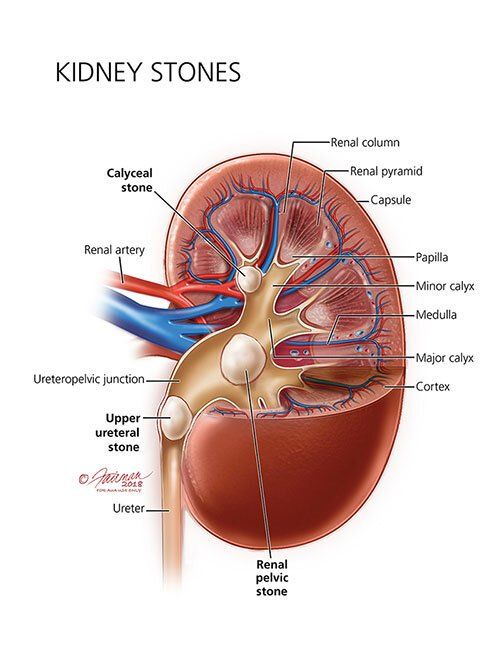Kidney Stones
WHAT ARE KIDNEY STONES?
Urine contains many dissolved minerals and salts. When your urine has high levels of these minerals and salts, you can form stones. Kidney stones can start small but can grow larger in size, even filling the inner hollow structures of the kidney. Some stones stay in the kidney, and do not cause any problems. Sometimes, the kidney stone can travel down the ureter, the tube between the kidney and the bladder. If the stone reaches the bladder, it can be passed out of the body in urine. If the stone becomes lodged in the ureter, it blocks the urine flow from that kidney and causes pain.

The Kidneys and Urinary System
The kidneys are fist-size organs that handle the body's fluid and chemical levels. Most people have two kidneys, one on each side of the spine behind the liver, stomach, pancreas and intestines. Healthy kidneys clean waste from the blood and remove it in the urine. They control the levels of sodium, potassium and calcium in the blood. The kidneys, ureters and bladder are part of your urinary tract. The urinary tract makes, transports, and stores urine in the body. The kidneys make urine from water and your body's waste. The urine then travels down the ureters into the bladder, where it is stored. Urine leaves your body through the urethra. Kidney stones form in the kidney. Some stones move from the kidney into the ureter. The ureters are tubes leading from the kidneys to the bladder. If a stone leaves the kidney and gets stuck in the ureter, it is called a ureteral stone.
SYMPTOMS
Common symptoms of kidney stones include a sharp, cramping pain in the back and side. This feeling often moves to the lower abdomen or groin. The pain often starts suddenly and comes in waves. It can come and go as the body tries to get rid of the stone.
other signs of a kidney stone include:
- A feeling of intense need to urinate.
- Urinating more often or a burning feeling during urination.
- Urine that is dark or red due to blood. Sometimes urine has only small amounts of red blood cells that can't be seen with the naked eye.
- Nausea and vomiting.
- For men, you may feel pain at the tip of the penis.
DIAGNOSIS
"Silent" kidney stones, those that cause no symptoms, are often found when an X-ray is taken during a health exam. Other people have their stones diagnosed when sudden pain occurs while the stone is passing, and medical attention is needed.
When a person has blood in the urine (hematuria) or sudden abdominal or side pain, tests like an ultrasound or a CT scan may diagnose a stone. These imaging tests tell the health care provider how big the stone is and where it is located.
A CT scan is often used in the ER when a stone is suspected. It is used because it can make a quick and exact diagnosis.
LEARN MORE
For consultation or appointments
All Rights Reserved | Site by Fix8

